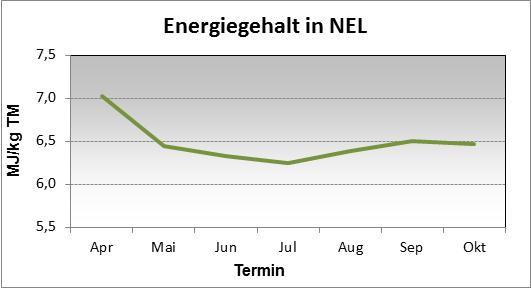In addition to the quantity yield of a grassland system, the quality of the feed is crucial for feeding. Protein and energy are largely responsible for the performance of farm animals. The plant population and the low growth height influence the forage quality on permanent pastures. The data base for this is very limited and is only available for climatically favorable locations.
Examination results:
The forage on the short grass pasture achieved energy contents of around 7 MJ NEL/kg DM up to the first cut. This energy concentration was determined in a test that lasted three years. As the process progressed, the energy concentration settled constantly between 6.3 and 6.5 MJ NEL/kg DM. This shows that the pasture feed has a relatively constant quality. These high energy concentrations could also be measured in other pasture experiments in Europe. What is interesting here is the fact that in the harsh climate of the Eastern Alps the growth time is shorter and the quantity yields are lower, but the ingredients reach the values of the grassland gunstorte.
Crude protein levels were also very high throughout the entire grazing period. The crude protein content in the feed from the short grass pasture fluctuated between 18 and 23%. The main influence on these high values was the proportion of white clover in the short grass pasture.
The low growth height on short grass pastures is usually associated with a low crude fiber content. In the present study, crude fiber contents of between 19 and 24% were measured when using short grass pastures. Although the pasture feed is very short, it has enough raw fiber to ensure ruminant feeding. However, it should be noted that high proportions of pasture feed in the ration that have these qualities do not make large concentrate supplementation possible.
In a further study, several types of grassland use were compared. The variants used as short grass pastures showed both the highest energy and the highest crude protein contents.
Figure 1: Energy content over the course of the year for 4 different grassland uses
Figure 2: Crude protein content over the course of the year for 4 different grassland uses






